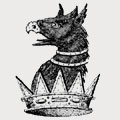Singapore - Sir Stamford Raffles’ Crested Silver Servers, 1824
£2,600.00
YEAR OF MANUFACTURE: 1824
ORIGIN: London, England
MAKER: William Chawner, London, 1810-1830
WEIGHT: 10.00 troy ounces (10.97 ounces or 311.03 grams)
STOCK CODE: mdwoa
Featured Crests

Item Description
Silver. King’s Pattern serving spoon and fork, each engraved with Sir Stamford Raffles’ armorial crest - out of an Eastern coronet, a griffin’s head, beaked Maker’s mark of William Chawner II. Hallmarked London 1824. Length: 30cm (11.75in)
Contained in a glazed display case for wall hanging (35cm x 20cm).
The present griffin crested King’s Pattern silver spoon and fork formed part of a service purchased by Sir Stamford Raffles in 1824 following the calamitous loss of his personal property and scientific collections in the ship Fame when returning to England from Sumatra in earlier that year. By that time Raffles had made his mark on history by the founding of modern Singapore. In the wake of the Napoleonic Wars, Britain returned Malacca and other Straits territories to the Dutch. Raffles foresaw that the Dutch would have complete control over Straits trade. Accordingly he sailed from Calcutta in 1818 in search of a new British settlement to replace Malacca and landed at Singapore accompanied by the Madras Army officer William Farqhuar and one sepoy. On Raffles's advice the East India Company purchased Singapore from the Sultan of Johore, and Raffles in person hoisted the British flag there on 29 February 1819, amongst the ruins of the fortifications of the ancient maritime capital of the Malays. His services to British commerce in selecting this site were enormous. Raffles worked ceaselessly to establish conditions under which the Free Port might flourish. These included a new town plan with residential, commercial and administrative districts; legal reform including the introduction of trial by jury; the abolition of slavery and public gaming; and not least the establishment of an institution of higher learning for the sons of the Malay chiefs.
Sir Thomas Stamford Raffles (1781-1826) was the son of a sea captain and due to family poverty toiled as a clerk in the East India Company’s London headquarters for ten years from the age of fourteen. His natural abilities won him a place as an assistant secretary to the Company’s new Presidency at Penang. Arriving there on 19 September 1805, Raffles spent almost twenty years in South East Asia. His unquenchable thirst for knowledge drove him to learn Malay and become a passionate scholar of all aspects of the Malay world. This expertise, in addition to the European and Asian contacts he built up in acquiring such knowledge, made Raffles an indispensable authority to be consulted by the Company and academics on any subject relating to the region. He was accordingly a key figure in the planning and execution of the 1811 capture of Java.
At the end of his career in South East Asia, he boarded the East India Company charter vessel Fame to take him and his family back to England from Sumatra. The vessel set sail at dawn on 2 February 1824 and began its long journey back to Britain. That very night, as Raffles and his wife prepared for bed, the ship caught fire. The fire spread fast, forcing a very quick evacuation of the ship. Amazingly everyone on board was saved, and watched from the lifeboats as the Fame exploded into flames and sank. Raffles and his family lost all of their personal possessions, including their silver and Lady Raffles’s jewellery, in addition to Raffles’ entire body of research and a scientific collection of incomparable value. When Raffles finally reached London, one of his first tasks was to draw up a statement - principally from memory - of his administration during the previous twelve years. It did not, however, fully justify him in the eyes of the East India Company directors. They censured his emancipation of the company's slaves and his annexation of Pulo Nias island, and, while generally approving his motives, they plainly disapproved of his zeal. Setting up house at Highwood, near Barnet, he occupied himself with the foundation of the Zoological Society, of which he was the first president. He died suddenly, when only forty-five years old in 1826.
OFFERED BY:
Heraldic Silver Ltd
By appointment only, London, United Kingdom View map
 Show this exhibitor's phone number
Show this exhibitor's phone number
 View all of this exhibitor's items
View all of this exhibitor's items
£2,600.00